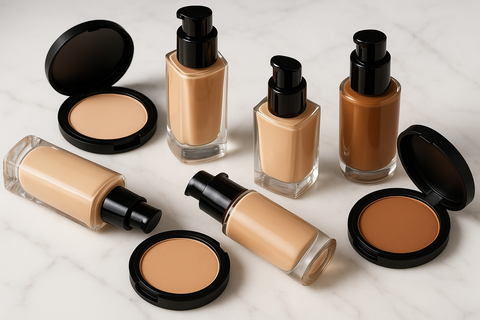Makeup foundation is a cosmetic composition that creates an even skin tone and improves skin conditioning. Common makeup formulations include liquid foundation, cream, powder, stick, mousse, and serum-based products. These makeup formulas work for different skin types, from oily areas to dry patches. They use moisturizing ingredients like hyaluronic acid or sodium hyaluronate. Cosmetic foundation has pigments. It also contains coverage pigments, color pigments, and filler ingredients for coverage. Titanium dioxide and zinc oxide powder act as opacifying agents. Mica powder and shimmer materials give a soft-focus finish. Particle size affects how stable the product is. It also changes the product's microbiological quality. Pigment dispersion also affects these qualities. Both affect the final look of the product.
Liquid and cream foundations
People like liquid foundation and cream formulas because they apply smoothly. They also offer flexible coverage. Many products are emulsions with oil in water. They have emulsifying agents, emulsifying wax, and binder materials. These help spread the pigmentary composition evenly. Moisturizing agents like argan oil, mango butter, and castor oil improve skin conditioning. They also help reduce transepidermal water loss. Silicone oil and C12-15 alkyl benzoate make application smoother. Volatility liquids control drying time. Wrinkle blur effects can make the skin look smoother. Acrylates/Dimethicone Copolymer helps keep emulsion particles stable. Ethoxylated Sorbitan ester also helps keep them stable. Ingredients like ginkgo extract or cocoa powder add antioxidants.
Mineral makeup and natural options
Mineral makeup uses minerals like zinc oxide powder, titanium dioxide, mica powder, and metallic stearates. These act as coverage pigments and opacifying agents without synthetic dyes. Fillers like Silica Dimethyl Silylate add texture. These fillers are acceptable for cosmetic use. Some mica comes from hydrothermal veins for a natural soft-focus finish. Natural lotion-style foundations or creme blush can use emulsifier for cosmetic creams. They may include a moisturizing agent blend for skin care benefits. The pigmentary composition can be adjusted for particle size and coverage. This makes them useful for cosmetics lines that blend makeup coverage with skin care products.
Specialized application techniques
The right makeup application tools make a big difference. A damp makeup sponge blends cosmetic foundation smoothly. A kabuki brush works well for powder makeup formulations. Airbrush gun techniques give a soft-focus finish. Using a primer first can boost moisturizing properties and improve pigment dispersion. Good color matching avoids uneven tones. Concealer can help hide dark circles. Shimmer materials and filler ingredients add a high-shine finish. Whether you have oily areas or dry patches, proper application improves coverage and product stability.
Formulation science and ingredients
Foundation makeup uses pigment dispersion. It also uses binder materials and fillers that are safe for cosmetics. These help create an even texture. Mango butter, argan oil, and sodium hyaluronate give moisturizing properties. Mica bordeaux and bronze powder add shimmer effects. Titanium dioxide and zinc oxide powder work as opacifying agents. They help coverage pigments hide skin imperfections. Stable emulsion particles keep the product stable. They also keep the product free from germs. Emulsifiers help keep cosmetic creams stable. Acrylates/Dimethicone Copolymer helps keep the product stable. Volatility liquids and silicone oil help control shine in oily areas. Filler ingredients and shimmer materials enhance the look. Ginkgo extract gives antioxidant benefits.
Production and packaging considerations
Making cosmetic foundation may use mixing tanks for liquid products. It may also use horizontal bead mill systems to spread pigments. Tube filling equipment and liquid foundation filling machines package the products. Airless dispenser designs keep the product free from germs. They also keep the product stable. Magnetic palette options are useful for multi-use products. Market trends show more demand for transfer-resistant foundations. These foundations also condition skin and have a high-shine finish or wrinkle blur effects. Lipstick molding solutions and minerals from hydrothermal veins help expand cosmetic lines. Packaging design must fit consumer needs, product stability, and market presence.
Key considerations for choosing a foundation
- Identify your skin type and select a fitting formula like mineral makeup, liquid foundation, or cream.
- Check makeup formulas for moisturizing properties and skin conditioning benefits.
- Understand coverage pigments, shimmer materials, and pigmentary composition to get your desired finish.
- Look at particle size, emulsion particle stability, and opacifying agents for performance.
- Use application tools such as a kabuki brush, damp makeup sponge, or airbrush gun.
Please contact us to get started with creating your own custom foundation makeup formulations.
